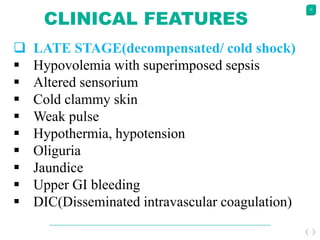Which of the Following Most Accurately Describes Septic Shock
Hyperventilation occurs and the blood pH rises. The CEN exam is composed of 175 multiple choice questions and you are given three hours to complete the examThere are twelve areas tested on the CEN exam.
Which types of shock are commonly seen in the infant who is septic.

. Which of the following statements accurately describes the ability of infants to transition. The following are some of the course we offer assignment help in. With a complete endocardial cushion defect.
This impairs movement and sensation and can cause issues with bowels bladder and vision. HvKp usually infects individuals from the community who are often healthy. A more thorough understanding of what general anesthesia entails may enable the critical care nurse to tailor care to patients following surgery.
There is no known cure for this condition but treatment is geared. Hypoxia occurs and lactic acid rises. MS comes in cycles of remission and exacerbation.
Cardiovascular - Respiratory - Medical Emergencies and Infections - Neurological - Orthopedics and Wounds - Gastrointestinal - Genitourinary Gynecological and Obstetrical - Environment and Toxicology - Professional. This article describes the stages of general anesthesia along with related medications potential adverse reactions and what nurses need to know to provide optimal care. Select the stage of shock that is accurately paired with its characteristic.
General economic factors including interest rate and currency exchange rate fluctuations. Viral infection of the blood vessels vascular damage and vasoconstriction B. Patients with CP often have spastic movements lack of muscle coordination excessive drooling or problems with speech.
Pathophysiology Chronic progressive demyelination of the neurons in the CNS. Etiology The cause of MS is unknown though suspected to have a genetic component. Reposition the infant with arms and legs flexed.
Pneumoniae hvKp is an evolving pathotype that is more virulent than classical K. Fluid and proteins leak into surrounding tissues and the blood. In addition to invasive and non-invasive ventilators high flow rate oxygen delivered at a controlled percentage via a dedicated nasal cannula has become more prevalent in the years since the.
The compensatory stage of shock. Widespread vasoconstriction and plasma loss due to a severe viral infection. This leads to spastic and slow nerve impulses.
Pathophysiology Cerebral palsy CP is a common group of neurological developmental disorders that affect a persons ability to move as well as muscle tone and posture. This Viewpoint makes the case that the importance of early detection of sepsis and the need for rapid antibiotics in patients with definite infection and possible septic shock has likely led to overuse of antibiotics in patients who might not need them and argues for testing to confirm infection in non-shock patients in place of rapid empirical antimicrobial treatment. We offer assignment help in more than 80 courses.
Infections are more common in the Asian Pacific Rim but are occurring globally. Bacterial damage to the vessel wall leaking blood vessels and vasodilation C. Which of the following is the MOST appropriate action.
Which of the following MOST accurately describes septic shock. Risks and uncertainties include but are not limited to general industry conditions and competition. We are also able to handle any complex paper in any course as we have employed professional writers who are specialized in different fields of study.
HvKp infection frequently presents at multiple sites or subsequently metastatically spreads. The progressive stage of shock. The initial stage of shock.
Sepsis is the most expensive health-care problem in the USA with a cost of more than 20 billion Sepsis is one of the most prevalent causes of mortality in intensive care units ICUs and its incidence increased by more than double over the last 10 years According to data from the Surviving Sepsis Campaign mortality rates from sepsis are 41. Acute kidney injury AKI is defined by a sudden loss of excretory kidney function. AKI is part of a range of conditions summarized as acute kidney diseases and disorders AKD in which slow.
From their experience they are able to work on the most difficult assignments. The SOFA score calls for patients to receive a score of 3 or 4 if they reach a PaO 2 FiO 2 ratio of less than 200 or less than 100 respectively and are receiving respiratory support.

Shock Types Pathogenesis Of Septic Shock Youtube

Sepsis And Septic Shock The Lancet

Definitions Of Sepsis And Septic Shock 13 15 Download Scientific Diagram

No comments for "Which of the Following Most Accurately Describes Septic Shock"
Post a Comment